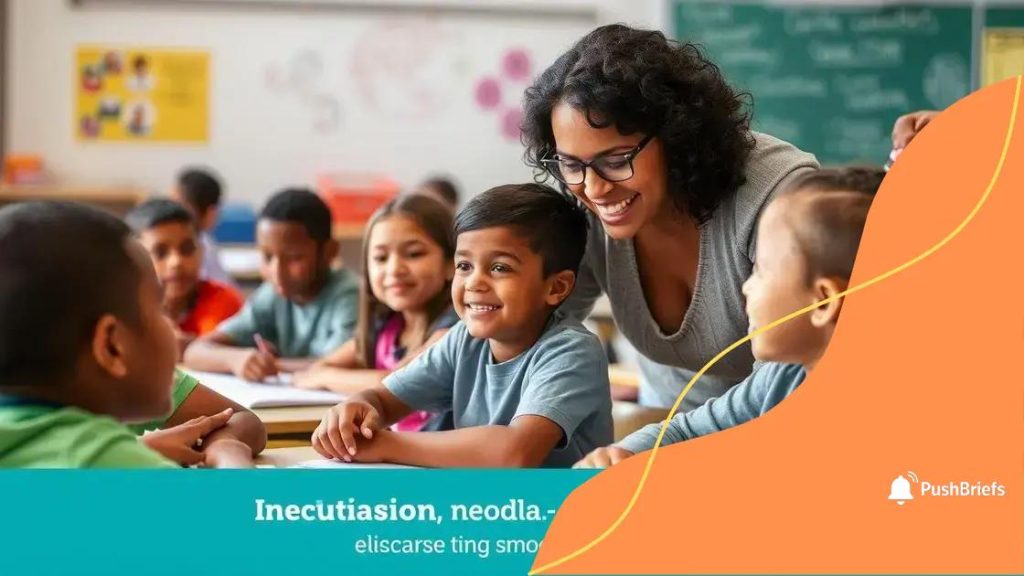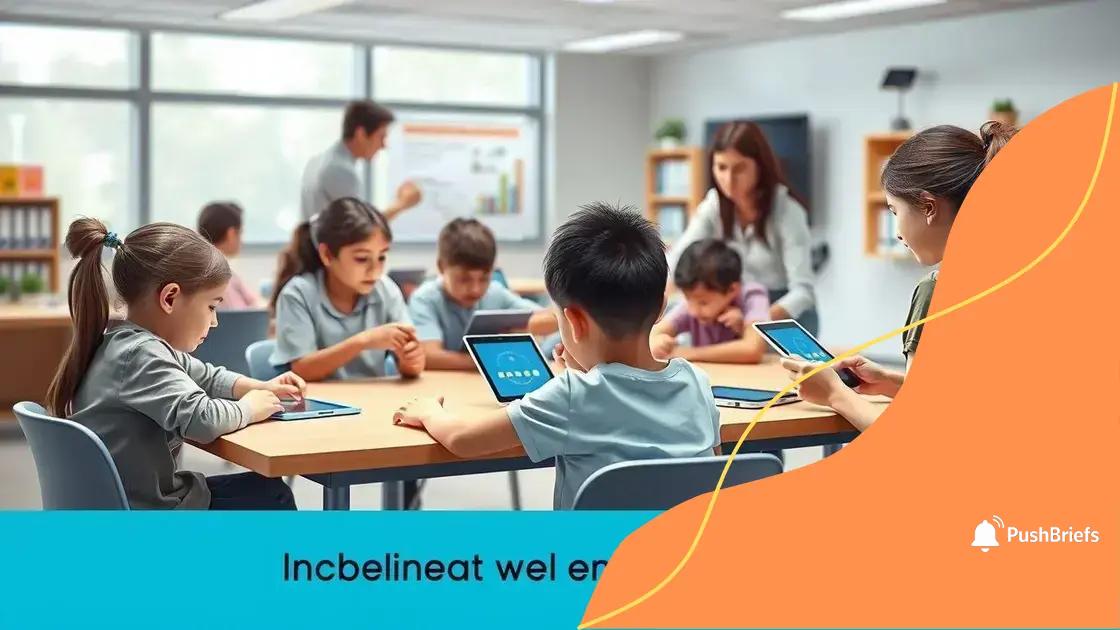The needs of students with special education requirements are being addressed

Addressing the needs of students with special education requirements involves effective collaboration between teachers, parents, and the community, along with innovative strategies that promote inclusion and support academic success.
The needs of students with special education requirements are being addressed in diverse and impactful ways. As more schools recognize the importance of tailored educational approaches, they are finding strategies that truly help these students thrive.
Understanding special education needs
Understanding special education needs is crucial for fostering an inclusive learning environment. These needs can vary greatly among students, and recognizing them is the first step in providing appropriate support. When we address these unique requirements, we help ensure that every student can thrive academically and socially.
The Role of Individualized Education Plans
One important tool in understanding special education needs is the Individualized Education Plan (IEP). An IEP outlines specific goals and supports tailored to each student. This plan is developed collaboratively by teachers, special education professionals, and parents.
- Sets personalized academic goals
- Identifies necessary accommodations
- Involves regular assessments
With a well-structured IEP, educators can focus on the unique strengths and weaknesses of each learner. This personalized approach can significantly enhance a student’s classroom experience.
Common Types of Special Education Needs
There are several types of needs that students may have, which could include learning disabilities, emotional disturbances, or physical impairments. By understanding these categories, educators can better implement effective strategies.
For instance, students with learning disabilities may benefit from one-on-one instruction or specialized curricula. Meanwhile, those with emotional disturbances might require a structured environment that offers stability and support.
- Learning disabilities (e.g., dyslexia)
- Attention Deficit Hyperactivity Disorder (ADHD)
- Autism Spectrum Disorder (ASD)
Recognizing these differences allows teachers to adapt their teaching styles and materials. Emphasizing hands-on activities or visual learning tools can be especially beneficial.
Overall, understanding special education needs equips educators with the knowledge to create a more inclusive classroom. This understanding not only benefits the students but also enriches the learning environment for everyone.
Benefits of addressing these needs
Addressing the needs of students with special education requirements brings a host of benefits, not only for the students themselves but also for the entire educational community. When we actively support these students, we create a more inclusive atmosphere that fosters growth and understanding.
Enhanced Academic Performance
One of the primary benefits is the improvement in academic performance. When students receive the help they need, such as tailored learning strategies and resources, they are better positioned to succeed in their studies. This targeted support can lead to increased engagement and understanding of the material.
- Greater retention of information
- Higher test scores
- Increased motivation to learn
Fostering an environment where these students can thrive academically helps instill confidence that carries into all aspects of their lives.
Improved Social Skills
Addressing special education needs also contributes to the development of essential social skills. By participating in structured programs and interactions with peers, these students learn to communicate effectively and collaborate on projects. This social development is vital for building friendships and enhancing their overall experience in school.
Additionally, when students learn in an inclusive environment, it encourages empathy and understanding among all classmates. They learn to appreciate differences and support one another.
Better Behavioral Outcomes
When educators recognize and address special education needs, it often leads to fewer behavioral issues. With appropriate support, students feel more understood and secure in their learning environment. This security can reduce frustration and acting out, creating a positive atmosphere in the classroom.
- Positive behavior reinforcement strategies
- Consistent routines that promote stability
- Access to counseling and support services
As students develop stronger self-regulation skills, the entire class benefits from a more focused and respectful learning environment.
Ultimately, the benefits of addressing these needs extend beyond academic achievement. The whole community grows stronger, fostering inclusion, acceptance, and respect for diversity.
Innovative strategies for support

Implementing innovative strategies for support is essential to effectively address the needs of students with special education requirements. Schools worldwide are adopting new methods to ensure that every student receives the attention and resources they need to succeed.
Use of Technology
One significant area of innovation is the use of technology. Tools such as tablets and specialized software programs can offer personalized learning experiences. These technologies allow students to learn at their own pace, benefiting from interactive lessons that engage them.
- Educational apps tailored for different learning styles
- Online resources for additional practice
- Assistive technology for communication and mobility
Technology not only makes learning accessible but also provides teachers with valuable data on student progress, helping them tailor their approaches.
Collaborative Learning Environments
Another innovative strategy is fostering collaborative learning environments. Group activities can encourage peer support among students with different abilities. By working together, students can learn from one another and build essential social skills.
Setting up buddy systems, where a student with special needs is paired with a peer, often results in improved academic and emotional outcomes. This approach promotes a sense of community and belonging.
Professional Development for Educators
It’s vital to provide ongoing professional development for educators. Workshops and training sessions focused on new teaching methods can empower teachers to implement innovative strategies effectively. As they learn about different ways to support their students, they become better equipped to address diverse needs in the classroom.
- Workshops on adaptive teaching techniques
- Collaborative planning sessions with special education experts
- Access to peer mentoring programs
By enhancing teacher skills, schools can create more supportive and nurturing environments for all students.
Implementing these innovative strategies can transform the educational landscape, ensuring that students with special education needs receive the support necessary for their growth and development.
The role of teachers and staff
The role of teachers and staff is vital in supporting students with special education needs. They are not just educators, but also advocates and mentors who greatly influence the lives of these students. Their efforts can lead to remarkable improvements in learning and personal development.
Understanding and Empathy
Teachers and staff must first understand the diverse needs of their students. It’s crucial for educators to develop empathy and build strong relationships. When teachers understand individual challenges, they create an environment where students feel safe and valued.
- Encouraging open communication
- Building trust through consistent support
- Recognizing and celebrating student achievements
Strong relationships can significantly enhance a student’s motivation and willingness to engage, making learning a more enjoyable experience.
Collaboration with Specialists
Another essential part of the teacher’s role involves collaborating with special education specialists. By working together, they can create tailored plans that address specific needs. This teamwork also ensures that instructional strategies are effective and appropriate for each student.
Regular meetings and discussions help keep everyone informed about student progress and any necessary adjustments to their learning plans.
Providing Consistent Support
Consistent support is critical in any inclusive classroom. Teachers must monitor students’ progress and provide feedback regularly. This ongoing assessment allows educators to adjust teaching methods to better suit individual learning styles.
- Utilizing progress tracking tools
- Implementing scaffolding techniques
- Offering additional help during or after class
By staying attentively engaged, teachers can help students achieve their goals and overcome obstacles.
Ultimately, the commitment and efforts of teachers and staff to understand, collaborate, and support students forge a path for success. Their role is truly instrumental in creating an inclusive educational atmosphere.
Involvement of parents and the community
The involvement of parents and the community is crucial for the success of students with special education needs. When families and community members engage actively in the educational process, it creates a stronger support system for students.
Building Strong Partnerships
Creating strong partnerships between schools and families can lead to better outcomes for students. When parents feel welcomed and valued, they are more likely to participate in school activities. This partnership can enhance communication and trust.
- Regular updates through newsletters and meetings
- Workshops to educate parents about special education
- Encouragement of parental input in decision-making
Such initiatives foster an environment where parents feel empowered to advocate for their child’s needs.
Community Support Programs
Involving the community is another key aspect. Community organizations can offer additional resources and services that help students thrive. This might include tutoring programs, counseling services, or extracurricular activities designed for children with special needs.
By collaborating with local businesses and organizations, schools can create a broader network of support. This expanded reach ensures that students have access to various opportunities.
Promoting Inclusion and Acceptance
When parents and community members participate, they help promote inclusion and acceptance within the classroom and the larger community. This involvement helps break down barriers and stereotypes surrounding special education. Activities that bring together students with and without disabilities can foster understanding and friendship.
- Community events celebrating diversity
- Peer mentoring programs
- Awareness campaigns in local schools
Through these collaborative efforts, the entire community benefits, creating a more equitable educational experience for everyone involved.
Ultimately, the active involvement of parents and the community significantly enhances the educational journey for students with special education needs. Their collective support makes a lasting difference in students’ lives.
FAQ – Frequently Asked Questions about Supporting Students with Special Education Needs
How can parents effectively support their children with special education needs?
Parents can support their children by staying engaged in school activities, communicating with teachers, and advocating for appropriate resources and services.
What role does technology play in special education?
Technology provides personalized learning experiences, enhances engagement, and offers tools that accommodate different learning styles for students.
Why is community involvement important for students with special needs?
Community involvement helps create a broader support network, providing additional resources, fostering understanding, and promoting inclusive opportunities.
What are some innovative strategies for supporting students with special education needs?
Innovative strategies include using assistive technology, implementing collaborative learning environments, and offering tailored professional development for teachers.
